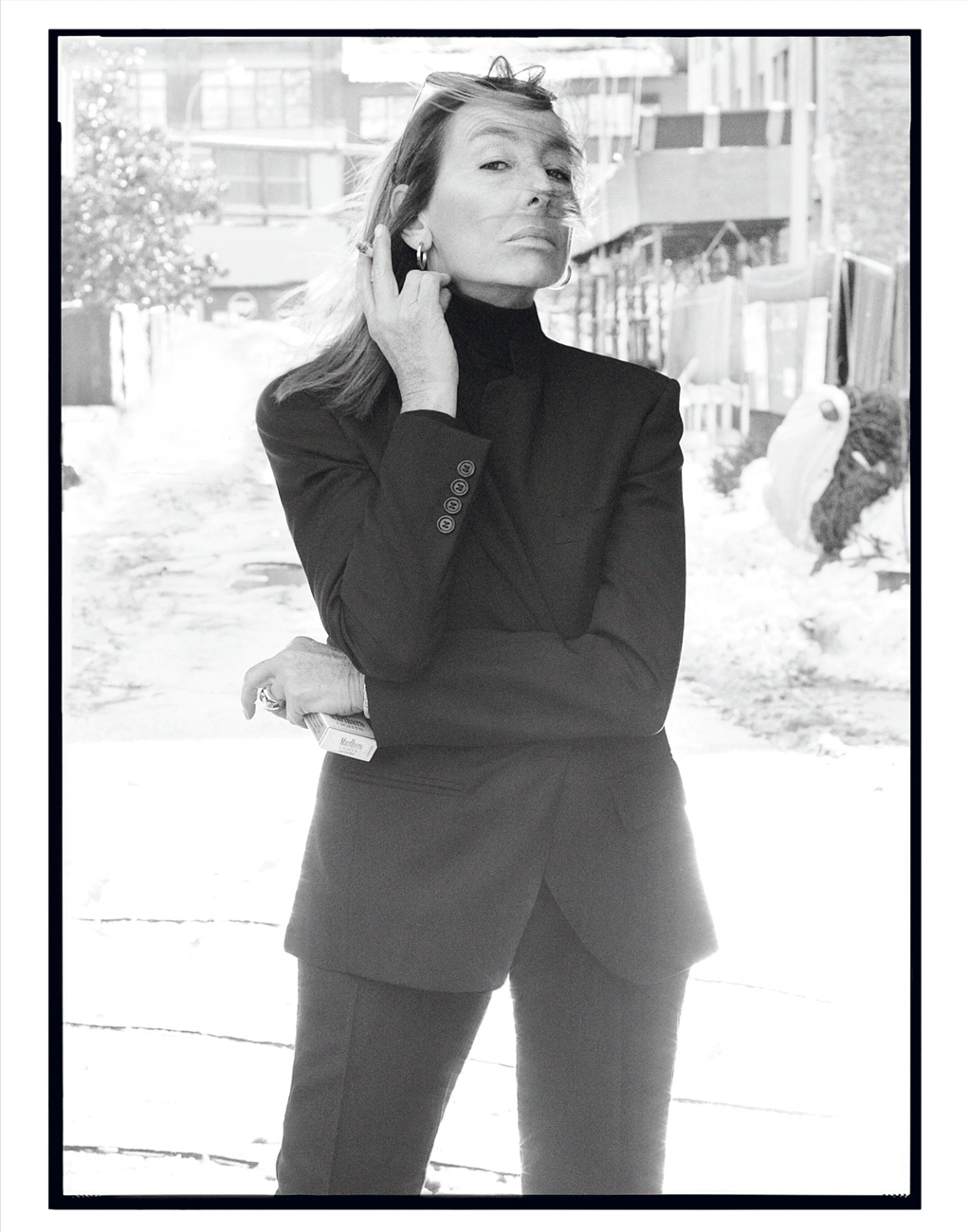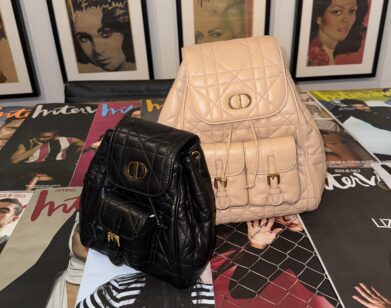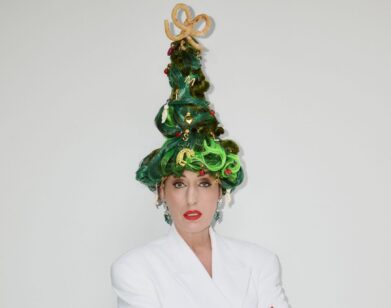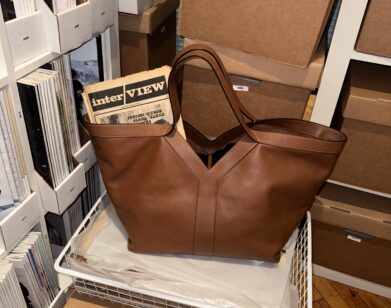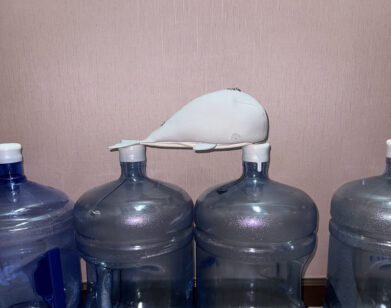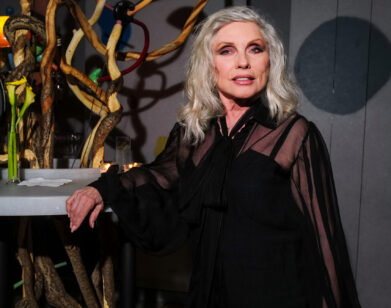Carlyne Cerf de Dudzeele
Over the last three decades, Carlyne Cerf De Dudzeele’s trademark has been remarkably consistent: an arm or a neck piled with accessories and vintage denim paired with a Chanel bag or a Hermès scarf, executed with a bravado and easy assurance that mimics her own personality. A stylist before the cult of the stylist took hold of the industry, De Dudzeele grew up in Saint-Tropez, where she observed the mix of haute couture with everyday essentials, worn simply and confidently among the artists and writers who lived there. She moved to New York in 1985, after ten years at French Elle, to become fashion editor at Vogue—where, among other distinctions, she styled the cover of AnnaWintour’s first issue (November 1988), shot by PeterLindbergh, and apprenticed with Richard Avedon and Irving Penn. Her work at the magazine over the next decade helped define the look of the iconic supermodels in the ’90s, such as Linda Evangelista, Christy Turlington, NaomiCampbell, and Claudia Shiffer. It’s also where she met herlongtime collaborator, Steven Meisel, who photographed her for this issue. (“I hate taking pictures of people I love,” Meisel wrote when asked what it was like turning his cameraon the stylist for the first time.)
Known for her ability to mix just about anything and make it work, De Dudzeele’s spring 2011 Blumarine show in Milan last fall was a vintage production—accessorized to the hilt, dramatic, and hilariously upbeat. She recently spoke with another friend, designer Azzedine Alaïa, whose clothes she has worn since 1981.
AZZEDINE ALAÏA: Carlyne, you rarely discuss your childhood.
CARLYNE CERF DE DUDZEELE: Well, my childhood comes from my mother. She was the most unimaginable woman I’ve known, so different from other women. My mother was eccentric, flamboyant, and extravagant, with inborn elegance. She was amazing, not frightened of anyone, absolutely not. She was brought up as a countess but was a total noncomformist.
ALAÏA: Did you receive a very French education?
DE DUDZEELE: A basic and strict education, sure, but intuition is the biggest factor. This most beautiful gift has given me a sense of freedom that I’ve always preserved.
ALAÏA: When did you consider the idea of going into fashion?
DE DUDZEELE: Do you remember the characters “The Lovers of Peynet” [by French illustrator Raymond Peynet]? I dressed up my dolls, inspired by the illustrations from these very elegant Parisian girls that he published in fashion magazines. His images from Paris made me adore fashion from Saint-Tropez, where we lived.
ALAÏA: What was it like growing up in Saint-Tropez?
DE DUDZEELE: At this time, Saint-Tropez was a quiet, beautiful little fishing village. People came for refuge. It was an elite group of people—painters, artists, writers. They all came to be together to celebrate life, with art-ness. The most important thing was to have fun. No one cared about fashion. People’s personality is what mattered.
ALAÏA: What types of clothes were you wearing as a girl?
DE DUDZEELE: Fashion was in my head, but I was not wearing fashion. I was in jeans, T-shirts, barefoot, most of the time. “Fashion” was not foremost in my mind. Style just came naturally. It was simple. This is what chic is, it is naturel. For me, the chicest thing in the world is la simplicite. J’adore!
ALAÏA: What do you think of when someone mentions the word “stylist?”
DE DUDZEELE: Not me. It doesn’t mean anything to me. I am not a “stylist,” per se. I do not understand the meaning of it. I never learned anything from it. I was born in a universe where fashion was introduced naturally from my mother and the people she associated with in Saint-Tropez.
ALAÏA: What sort of things did people wear in Saint-Tropez?
DE DUDZEELE: Fashion was not a question of clothes. It was more about attitude, intelligence, the way to be, the simplicity of it. The personality of all these people at this time was much more than clothes. No one cared. It was not about money, it was about having fun. Now, people judge you by the names you wear—it’s fake. It did not make any difference if you rode in a 2 CV, Vespa, or convertible Jaguar E-Type. Saint-Tropez, before it was invaded by nouveaux riches, ploucs, and tourists, was the best place in the world.
ALAIA: Do you go back often?
DE DUDZEELE: Never in the summer, no way!
ALAÏA: When you got started, in a sense, you felt the desire to photograph, to just run with your idea?
DE DUDZEELE: It came by chance, the opportunity presented itself and I dove in headfirst. In my mind, I always have some conception of the final image that I want to produce—a kind of vision that obsesses me and doesn’t leave me until I bring it to life. But also, I find this kind of osmosis when I work with certain photographers that gives me immense pleasure. When I work with Steven Meisel, we give each other everything we have. Something special occurs when we work together. There is a real and dynamic chemistry, and it’s everything that I love most in the world!
ALAÏA: You had real training with some famous photographers, with masters, like [Irving] Penn . . .
DE DUDZEELE: I had an extraordinary relationship with him. When I saw him, I would cry! I had the privilege to work with very talented photographers at Vogue like Richard Avedon, Penn, Meisel . . .
ALAÏA: They left their mark on history! Do you remember when Richard Avedon wanted to create my portrait with Stephanie [Seymour]? He wanted me to make facial expressions so that I looked like the devil. He had a point of view, a vision.
DE DUDZEELE: It was brilliant! I remember. . . . He imposed his vision on you.
ALAÏA: At times, a photographer can influence fashion with his photographic vision. In this same way, I believe that a photograph can bring the object into another dimension. I remember when you photographed some of my accessories on the beach. It was beautiful—my accessories entered another world.
DE DUDZEELE: When you create a beautiful and compelling photo, you can sometimes save an article of clothing.
ALAÏA: Are there any young photographers who you think are defining this period in the way that Avedon, Penn, and [Helmut] Newton defined their time?
DE DUDZEELE: It’s a different time now, and it’s interesting to see how it is changing. I love looking at photographers from the street, the bloggers. I love the internet, I’m obsessed with it. I love the idea that everyone has access to fashion. I spend too much time on it!
ALAÏA: Do you have any particular affinity with models whose looks match your vision?
DE DUDZEELE: Girls like Naomi [Campbell], Christy Turlington, Linda Evangelista, Kirsten McMenamy. For me, they are my real sources of inspiration. Many times, models look divine when they arrive at the studio. Sometimes, after hair, makeup, and fashion, they don’t look fresh and divine anymore.
ALAÏA: And these days?
DE DUDZEELE: I conjure up a girl, and it is from her persona and inspiration that I create a story. I want to translate this story into a photographic image.
ALAÏA: I know you are passionate about cooking. Do you have a similar pleasure when you’re in the kitchen as when you prepare for a camera shoot?
DE DUDZEELE: I am obsessed either way! When I prepare a shoot I am completely immersed in the subject. I am out of this world, inside my imaginary world and within the picture. It’s the same as a gluttonous appetite when I am cooking. I am in the pot! I want this human intensity.
ALAÏA: What do you bring to fashion?
DE DUDZEELE: I don’t follow trends. I interpret fashion and I create my own story. I conjure up the image of the girl. I always have done it and I always will! C’est tout ce que j’aime! Ca me rend dingue!
ALAÏA: A fashion designer and a creator is one thing; a photographer is also another thing. This allows you to divide up fashion into different categories. You’re given these building blocks and then you create something with it. So your creativity is always within you; you assemble, you construct, and then you imagine.
DE DUDZEELE: You know, I love women. I love to show off women in all of their beauty, constantly moving in life. It makes me completely crazy! In life, women are to be looked at by men. This is the nature of it. Women should always be sexy, feminine, and desirable. This is what I have in my mind, this is why I do my own salad this way, because I love powerful, strong, sexy, and sophisticated women that men would follow in the street!
ALAÏA: How do you feel about the current celebration of the stylist?
DE DUDZEELE: Stylists should remain behind the scenes. A great stylist, like a great designer, lets the work speak for itself.
ALAÏA: Sometimes, Carlyne, one gives you the least interesting article of clothing and you transform them into beautiful pictures. For instance, you place three bags and tons of jewelry in an image and it becomes something extraordinary. Do you remember the page spread with Jean-Baptiste Mondino? With all the girls wearing panther [skins?], like savages? You always followed your obsessions!
DE DUDZEELE: Yes, but sometimes, I create certain images that overwhelm me. What occurs in the street fascinates me. I love it. If you have personal style, you can mix anything and be the chicest person in the world. Chic is not about money. It’s all about trafficotage! In France, we call it “avoir du chien.”
Azzedine Alaïa is a fashion designer based in Paris.

